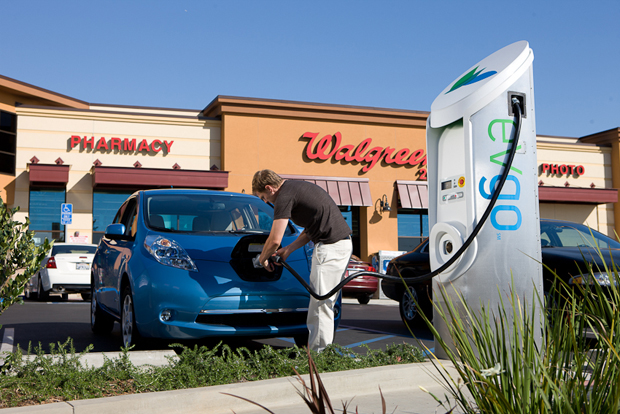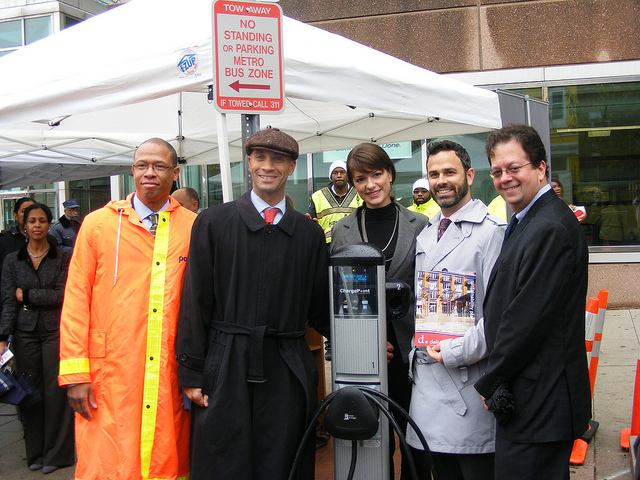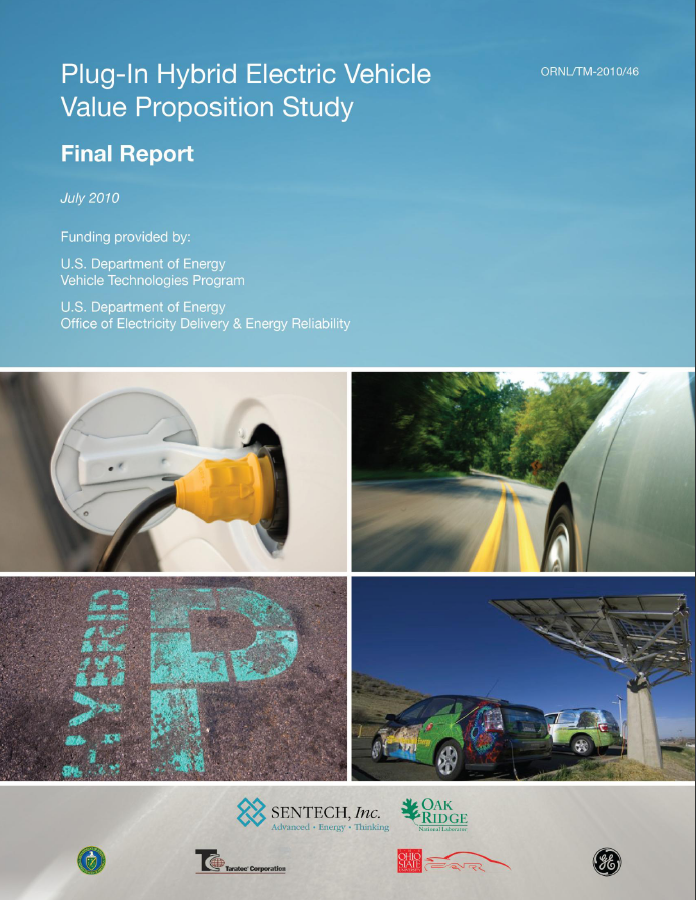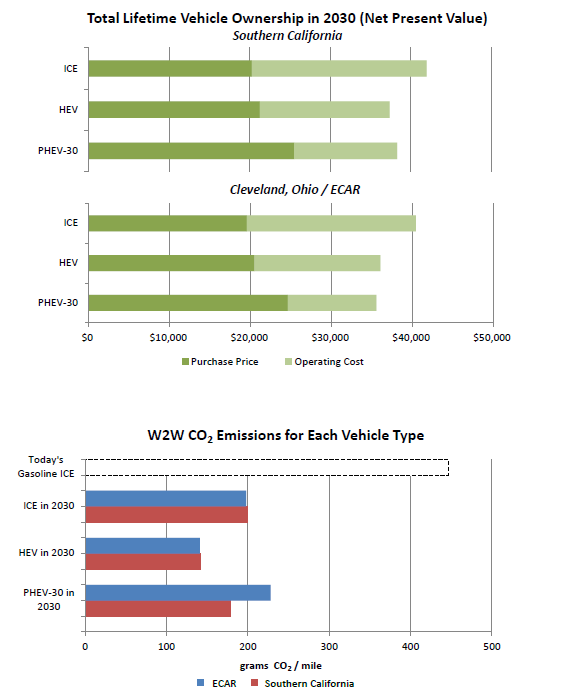Electrifying Houston – City Gets Private Electric Car Charging Network
(Source: Good)
Houston, Texas, may end up being the first American city with a great electric car charging infrastructure. NRG Energy is rolling out what is supposedly the world’s first privately funded comprehensive electric vehicle ecosystem. Here are some interesting nuggets:
- The system (or “ecosystem,” in their overwrought marketing speak), called eVgo, employs a very interesting business model. Subscribers sign a three-year contract and then pay a monthly fee, ranging from $49 to $89, for both a home charger and varying levels of access to this network of public chargers.
- NRG plans to install between 50 and 150 high-speed chargers in public places— shopping centers and the like—by the end of 2011. They’ll also be installing chargers in people’s homes.
- The high-speed chargers distributed around the city can charge a car to 80 percent within 30 minutes.
Related articles
- NRG Installs Privately-Funded Electric Car Charging Network in Oily Houston (fastcompany.com)
- NRG Launches Nation’s First Privately Funded, Comprehensive Electric Vehicle Charging Ecosystem (eon.businesswire.com)
- NRG Energy Selects AeroVironment to Build the Nation’s First Privately-Funded Electric Vehicle Charging “Ecosystem” (eon.businesswire.com)
- Walgreens and NRG Energy Work Together to Bring Nation’s First Privately Funded, Comprehensive Electric Vehicle Infrastructure to Houston (eon.businesswire.com)
- Reliant Customers Among the First with Access to eVgo Electric Vehicle Charging Network (eon.businesswire.com)
- NRG Energy Launches Network Of Electric Car Chargers, In Houston (blogs.forbes.com)
- A Private Network for Recharging Cars (green.blogs.nytimes.com)
- Why Texas May Be a Better Electric Car State Than California (nytimes.com)
- Unlimited Juice Electric Vehicle Charging Plans: Good Idea or Exploitation? (allcarselectric.com)
- NRG: Nation’s First Privately Financed Vehicle Charging Network (gigaom.com)
- On the GreenBeat: Trilliant Inks Deal With British Gas, NRG Energy Launches Charging Infrastructure (nytimes.com)
The Perfect Holiday Gift – Cycle Chic Calendar for 2011
(Source: Copenhagen Cycle Chic)
This incredibly awesome Cycle Chic Calendar for 2011 by the Mikael Colville-Andersen of Copenhangen Cycle Chic would make a great holiday gift for the Treehugger, biker, Transportation geeks (like me). Oh well, I’d say go off the limb and say this: in general this is for anyone who likes beautiful things – beautiful women, beautiful city streets and beautiful bikes carrying beautiful women. Available for purchase [and in time for Christmas] over at Lulu.com.
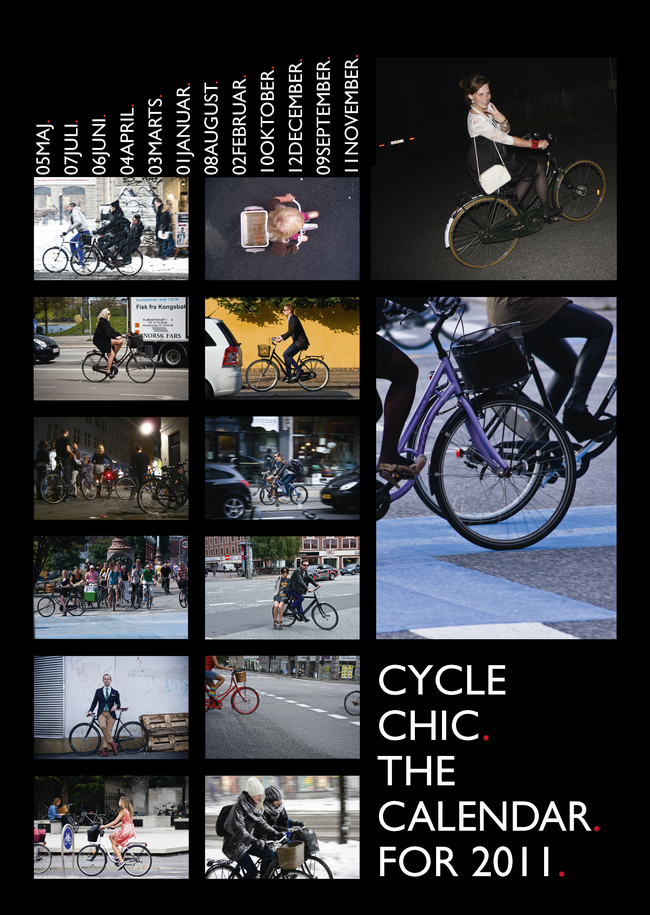
Downtown From Behind On Bikes- Aussie Photog Artfully Captures The “Heartbeat of New York City”
(Source: New York Times)
ONE is wearing a couture gown, another just a pair of red underwear. One is lugging a huge bouquet of flowering rhododendrons on his shoulder, another a suckling pig. They are all riding bicycles in the middle of streets downtown, and they are all shown from behind, having passed by, headed toward some unknown destination — a party, a garden, a pig roast.
The photographs are by Bridget Fleming, 30, who moved to the Lower East Side from Australia in 2008. She is halfway through an ambitious project to capture downtown denizens riding on two wheels down each of the approximately 200 streets below 14th Street. She posts some of the photographs on a blog, Downtown From Behind, and hopes the project, which she describes as a glamorous ode to “the heartbeat of New York,” will culminate this spring with a gallery exhibition and Web site.
Click here for more on this story and for the awesome interactive.
With this new hour glass design, you will never get a ticket for red light jumping
(Source: Gizmodo)
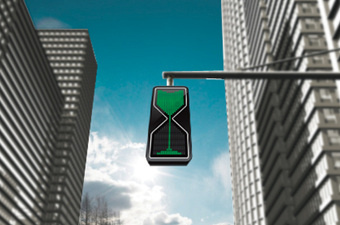
Image Courtesy: Gizmodo
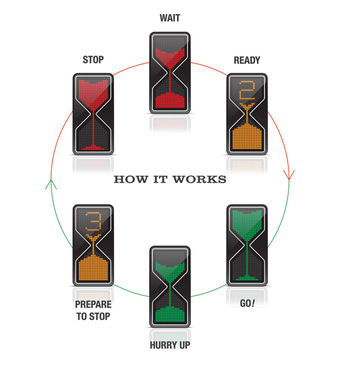
Image Courtesy: Gizmodo
It’s an incredibly simple idea: LED lights trickle down in a virtual sand glass that countdowns how much more Red and Green there will be. When it approaches 3 seconds left, the LEDs switch to yellow and give you an exact count on what’s left.
Click here to read the entire article.
Related articles
- Innovative Sand Glass Traffic Light Uses Hourglass Design to Show How Much Time is Left (techeblog.com)
- Hourglass LED Traffic Light Design Concept (laughingsquid.com)
- Hour Glass LED Traffic Lights [Pic] (boredpanda.com)
Causing a Stir – Obama’s ‘Beast’ gets tongues wagging at the green NATO summit
(Source: AFP via Yahoo)
The Portuguese hosts of Friday’s NATO summit hoped to use the event to promote clean-energy and electric cars, but all eyes were on US President Barack Obama’s diesel-guzzling “Beast” instead.
As is usual when he travels, Obama’s eight-tonne armoured behemoth of a limousine was flown out to Lisbon before the US leader’s arrival, and it ferried him from the airport tarmac to his first meetings of the weekend.
Doubtless he didn’t intend the Beast’s roar to drown out his hosts’ green message, but a US presidential motorcade and its attendant escort of Secret Service SUVs do attract attention, even at the most elite gatherings.
Click here to read the entire article
Related articles
- Obama’s gas-guzzling ride anything but green (capitolhillblue.com)
- Obama’s ‘Beast’ of a limo stands out at green NATO summit (alternet.org)
- At NATO summit, Obama’s ride is talk of the town – Christian Science Monitor (news.google.com)
- Obama is right (blogs.dailymail.com)
- Obama promises renewed NATO at summit (alternet.org)
- NATO summit of the decade opens in Lisbon (topinews.com)
- Obama In Lisbon: U.S. Looking Forward To NATO Alliance ‘For The 21st Century’ (huffingtonpost.com)
- WHITE HOUSE NOTEBOOK: Bo and ‘the Beast’ (seattletimes.nwsource.com)
- WHITE HOUSE NOTEBOOK: Bo and ‘the Beast’ (foxnews.com)
- Obama arrives in Portugal for NATO summit (foxnews.com)
Finally! Washington, DC Unveils First Public Curbside ChargePoint Charging Station
Washington, DC’s first public curbside 240V Level II Coulomb ChargePoint station is now located at the Franklin D. Reeves Center, 2000 14th Street, in northwest DC. There are two spaces available for charging vehicles on the west side of 14th Street adjacent to the Reeves Center. The installation of the ChargePoint station was done by PEPCO and Coulomb distributor NovaCharge, LLC.
Mayor Adrian M. Fenty today, along with the Department of Energy Undersecretary Cathy Zoi, District Department of Transportation Director Gabe Klein and other officials unveiled the first curbside electric car charging station in the District.
“This is yet another fantastic way the District is at the forefront of providing alternative and environmentally friendly transportation options for District residents and visitors,” said Mayor Fenty. “We are excited to make this technology available and easily accessible to everybody.”
Click here to read the full story.
Related articles
New Study Report Makes a Strong Case for Plug-In Hybrid Electric Vehicles
The U.S. Department of Energy’s Alternative Fuels and Advanced Vehicles Data Center has released a report that evaluates value-added propositions for plug-in hybrid electric vehicles (PHEVs) that might help overcome the initial price premium related to comparable internal combustion engine and hybrid electric vehicles. The report also assesses other non-monetary benefits and barriers related to an emerging PHEV fleet, including environmental, societal, and electric grid impacts.
Here is a quick peek into the study’s background, objectives, results and conclusions as shown in the fact sheet:
- To identify and evaluate value-added propositions for PHEVs that will help overcome the initial price premium relative to comparable ICEs and HEVs and
- To assess other non-monetary benefits and barriers associated with an emerging PHEV fleet, including environmental, societal, and grid impacts.
Results:
Study results indicate that a single PHEV-30 on the road in 2030 will:
- Consume 65% and 75% less gasoline than a comparable HEV (Hybrid Electric Vehicle) and ICE (Internal Combustion Engine), respectively.
- Displace 7.25 and 4.25 barrels of imported oil each year if substituted for equivalent ICEs and HEVs, respectively, assuming 60% of the nation’s oil consumed is imported.
- Reduce net ownership cost over 10 years by 8-10% relative to a comparable ICE and be highly cost competitive with a comparable HEV.
- Use 18-22% less total W2W energy than a comparable ICE, but 8-13% more than a comparable HEV (assuming a 70/30 split of E10 and E85 use in 2030).
- Emit 10% less Well to Wheel (W2W) CO2 than equivalent ICEs in southern California and emits 13% more W2W CO2 than equivalent ICEs in the ECAR region. This also assumes a 70/30 split of E10 and E85 (ethanol blends) use in 2030.
Conclusions:
PHEVs and other plug-in vehicles on the road in 2030 may offer many valuable benefits to utilities, business owners, individual consumers, and society as a whole by:
- Promoting national energy security by displacing large volumes of imported oil.
- Supporting a secure economy through the expansion of domestic vehicle and component manufacturing.
- Offsetting the vehicle’s initial price premium with lifetime operating cost savings (e.g., lower fuel and maintenance costs).
- Supporting the use of off-peak renewable energy through smart charging practices. However, smart grid technology is not a prerequisite for realizing the benefits of PHEVs.
- Potentially using its bidirectional electricity flow capability to aid in emergency situations or to help better manage a building’s or entire grid’s load.
PHEVs and other plug-in vehicles still face barriers to commercial acceptance:
- In the near term, the cost of energy storage, charging equipment, and PE&EM components must continue to descend to competitive levels, such as the ones assumed in this study. Industry trends imply that these cost reductions are on track to reach competitive price levels.
- PHEVs’ inability to reduce carbon emissions relative to ICEs unless they are powered primarily by non-carbon energy sources. A grid-connected vehicle’s high dependence on its region’s generation mix is very evident in this study’s findings. Operating in regions with a high percentage of non- or low-carbon energy sources (e.g., renewable, nuclear, and natural gas) would ultimately help improve the long-term environmental impacts of PHEVs.
Note: The Acronym PHEV-30 stands for Plug-in Hybrid Electric Vehicle with an All Electric Range (AER) equivalent of 30 miles.
Click here to download/access the entire report (PDF – 218 pages long).
Related articles
- Study Finds Public Policies Needed to Boost EV Fleet Purchases (environmentalleader.com)
- Electric Vehicle Sales in Asia Pacific to Total 1.4 Million by 2015, Forecasts Pike Research (eon.businesswire.com)
- Electrification Coalition Releases Plan for 16M Electric Fleet Vehicles (solarfeeds.com)
- “Plug-in Prius is NOT a plug-in hybrid electric vehicle!” and related posts (hybridcarblog.com)
- Pike survey finds unproven technology and reliability concerns may hinder consumer demand for plug-in electric vehicle, although about 44% of respondents are interested in purchasing one (greencarcongress.com)
- Reportlinker Adds Hybrid Electric Vehicles for Fleet Markets (prnewswire.com)
- 3.2 Million Plug-in Electric Vehicles to be Sold Worldwide by 2015, Forecasts Pike Research (eon.businesswire.com)
- Electrification Coalition releases Fleet Electrification Roadmap; suggests fleet adoption could put a cumulative 200,000 PHEVs and EVs on the road by 2015 (greencarcongress.com)
- Pike forecasts Asia-Pacific to be largest PEV market, with more than 1.2M units by 2015; China to represent 53% of total sales (greencarcongress.com)
- Bloomberg New Energy Finance forecasts plug-in electric vehicles could account for up to 9% of US auto sales in 2020 and 22% in 2030 (greencarcongress.com)
- J.D. Power forecasts hybrid- and battery-electric vehicles will represent 7.3% of global auto sales in 2020 (greencarcongress.com)
- Hybrid Fleet Vehicle Sales to Surpass 740,000 Units per Year in 2015, According to Pike Research (eon.businesswire.com)
- Plug-In EV Market to Sell 3.2M Units by 2015 (environmentalleader.com)
- BeFrugal.com Proposes Cost Equivalent MPG Calculation for Electric Vehicles (prnewswire.com)
Job Alert: Legislative Director for National Transportation Reform Campaign (T4America) – @ Washington, DC
 The Transportation for America (T4America) Campaign is looking for an experienced, highly skilled individual with knowledge and interest in federal transportation policy and the federal legislative process to help develop and implement the Campaign’s government relations strategy.The T4America Campaign is a national advocacy campaign working to ensure that the next generation of transportation investments helps to make our country more competitive globally; improves mobility options for people of all ages, incomes and geographic areas; maintains our existing transportation assets in good and safe working order; and helps our nation reduce its carbon footprint.The campaign represents a broad coalition of housing, aging, environment, community development, business, planning, urban design and transportation interests. The Legislative Director works with the Campaign’s Director and other members of the Campaign’s leadership, and supervises other members of the Legislative Team.
The Transportation for America (T4America) Campaign is looking for an experienced, highly skilled individual with knowledge and interest in federal transportation policy and the federal legislative process to help develop and implement the Campaign’s government relations strategy.The T4America Campaign is a national advocacy campaign working to ensure that the next generation of transportation investments helps to make our country more competitive globally; improves mobility options for people of all ages, incomes and geographic areas; maintains our existing transportation assets in good and safe working order; and helps our nation reduce its carbon footprint.The campaign represents a broad coalition of housing, aging, environment, community development, business, planning, urban design and transportation interests. The Legislative Director works with the Campaign’s Director and other members of the Campaign’s leadership, and supervises other members of the Legislative Team.
- The Legislative Director must possess detailed knowledge of Capitol Hill, the relevant committees, and the legislative process. This position develops and directs the legislative strategy for the Campaign, including building strong relationships with Congressional leaders and their staff members.
- The Legislative Director will develop the Campaign’s Legislative work plan which would include such elements as an assessment of federal policy makers on relevant committees, or key districts, draft legislation, research on relevant previous bills or amendments, and Congressional briefings and outreach strategies.
- The Legislative Director will also provide assistance, as needed, to the Field and Outreach team in strategies to engage and coordinate state and local partners. While this team’s priority will be the federal transportation authorization bill, it will also engage with related bills such as those addressing climate change, energy, and appropriations.
Minimum of 5 years experience on Capitol Hill, with a government relations firm or non-profit engaged in government relations work is required, with legislative program management experience strongly preferred. An advanced degree ishelpful, as is experience with transportation policy. Also strongly preferred is experience working in a campaign environment. The applicant should possess excellent communications and research skills. Knowledge of the legislativeprocess is essential, as well as the ability to think strategically and in a bipartisan manner.The position is full-time and available starting August 2010. Salary is commensurate with experience, and includes benefits. Please send a cover letter and resume to Lea Schuster, Deputy Director at lea.schuster@t4america.org. In the subject line write T4America Legislative Director Position. For more information about us please visit our website www.t4america.org.
Going Green!DOT, EPA Propose the Nation’s First Greenhouse Gas and Fuel Efficiency Standards for Trucks and Buses

- Image via Wikipedia
(Source: USDOT)
The U.S. Environmental Protection Agency ( EPA) and the U.S. Department of Transportation today announced the first national standards to reduce greenhouse gas (GHG) emissions and improve fuel efficiency of heavy-duty trucks and buses. This comprehensive national program is projected to reduce GHG emissions by nearly 250 million metric tons and save 500 million barrels of oil over the lives of the vehicles produced within the program’s first five years.
EPA and DOT’s National Highway Traffic Safety Administration (NHTSA) are proposing new standards for three categories of heavy trucks: combination tractors, heavy-duty pickups and vans, and vocational vehicles. The categories were established to address specific challenges for manufacturers in each area. For combination tractors, the agencies are proposing engine and vehicle standards that begin in the 2014 model year and achieve up to a 20 percent reduction in CO2 emissions and fuel consumption by 2018 model year. For heavy-duty pickup trucks and vans, the agencies are proposing separate gasoline and diesel truck standards which phase in starting in the 2014 model year and achieve up to a 10 percent reduction for gasoline vehicles and 15 percent reduction for diesel vehicles by 2018 model year (12 and 17 percent respectively if accounting for air conditioning leakage). Lastly, for vocational vehicles, the agencies are proposing engine and vehicle standards starting in the 2014 model year which would achieve up to a 10 percent reduction in fuel consumption and CO2 emissions by 2018 model year.

- Image via Wikipedia
Overall, NHTSA and EPA estimate that the heavy-duty national program would provide $41 billion in net benefits over the lifetime of model year 2014 to 2018 vehicles. With the potential for significant fuel efficiency gains, ranging from seven to 20 percent, drivers and operators could expect to net significant savings over the long-term. For example, it is estimated an operator of a semi truck could pay for the technology upgrades in under a year, and save as much as $74,000 over the truck’s useful life. Vehicles with lower annual miles would typically experience longer payback periods, up to four or five years, but would still reap cost-savings.
EPA and NHTSA are providing a 60-day comment period that begins when the proposal is published in the Federal Register. The proposal and information about how to submit comments is at: http://www.epa.gov/otaq/climate/regulations.htm and http://www.nhtsa.gov/fuel-economy .
Click here read the USDOT presser on this issue.
Related articles
- Government seeks truck fuel efficiency rules (msnbc.msn.com)
- Government to propose truck fuel efficiency rules (seattletimes.nwsource.com)
- Government to propose truck fuel efficiency rules (sfgate.com)
- Government to Propose Truck Fuel Efficiency Rules (abcnews.go.com)
- Proposal Pending on Mileage for Heavy-Duty Vehicles (nytimes.com)
- Federal Agencies Push Renewable Energy, Truck Fuel Efficiency (environmentalleader.com)
- Garbage Trucks Go Green (technologyreview.in)
- Gov’t calling for better gas mileage for trucks (seattletimes.nwsource.com)
- EPA to propose truck fuel efficiency standards (marketwatch.com)
- Report: EPA poised to outline medium- and heavy-duty truck emissions standards (autoblog.com)
- EPA to Release Draft Greenhouse Gas Emission Limits for Heavy Trucks (nytimes.com)


